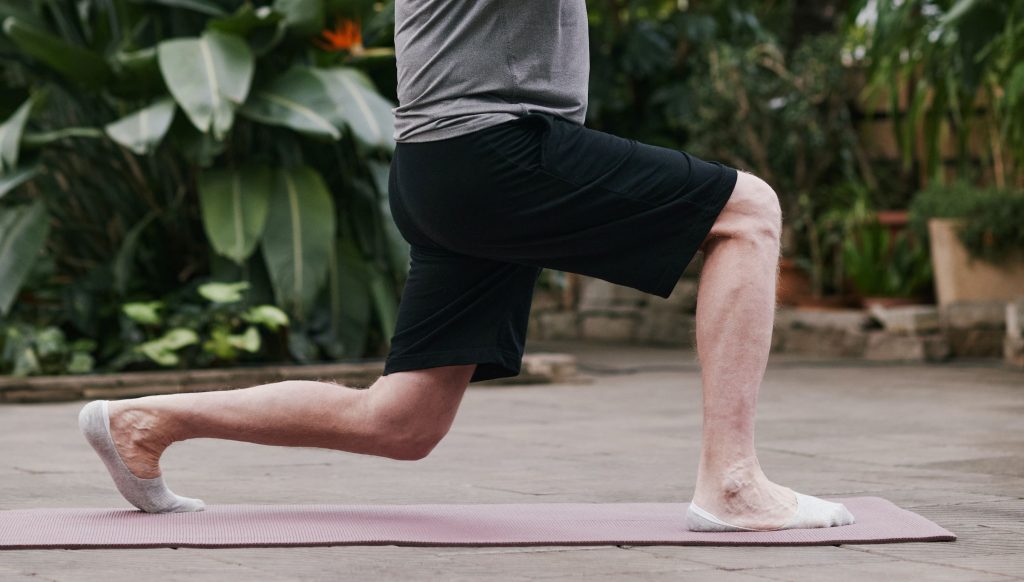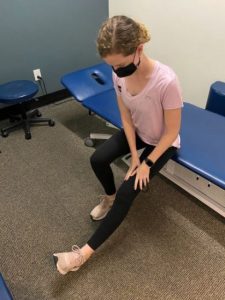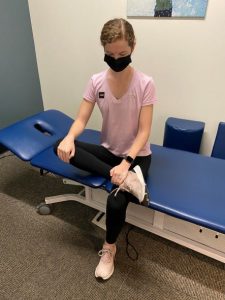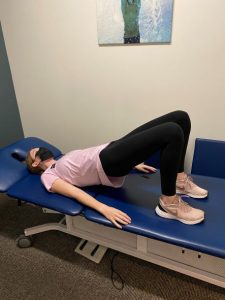
Osteoarthritis is a common condition that many people develop, commonly due to age related wear and tear of the hip joint. It can occur in any joint, but most often occurs in weight bearing joints like the hip and knee.
Symptoms of osteoarthritis at the hip may include pain in or around the hip joint, stiffness, clicking sounds with movement, and weakness. While hip arthritis is usually a chronic condition, treatment with physical therapy can help ease and reduce further damage.
What is Hip Arthritis?
Hip arthritis is the wear and tear or deterioration of the cartilage at the hip joint. The hip joint is a ball-and-socket joint that allows motion and gives stability required for weight bearing. There is cartilage between the ball (head of the femur) and the socket (acetabulum) which acts as a slippery coating to allow smooth movement. The labrum is a strong piece of cartilage that lines the hip socket and provides stability. When the cartilage wears away it becomes rough and frayed, and the joint space decreases. This narrowing may cause the damaged bones to create bone spurs or “osteophytes”.
Arthritis is very common—roughly 1 in 4 US adults have it (1). There are certain behaviors and characteristics, known as risk factors, which can increase your likelihood of developing arthritis. There are modifiable risk factors which you can change, and non-modifiable risk factors that you can’t change. You should focus on the risk factors that are modifiable to reduce your risk of arthritis.
Risk Factors
- Increasing age, typically over 50 years old
- Family history of osteoarthritis
- Being a female
- Obesity
- Previous injury to the hip joint
- Working in a job that requires repetitive bending and squatting activities
- Abnormal formation of the hip joint at birth
Symptoms
While some people may not experience symptoms with hip arthritis, those who do can have a wide range of different symptoms. The most common symptom of hip osteoarthritis is pain which comes on gradually and typically worsens over time. People sometimes find that the pain comes and goes.
Pain and stiffness is typically worse in the morning, at the end of the day, or after sitting for a prolonged period of time. This pain can radiate into the thigh, buttocks, groin, lower back, or knee. Sometimes it can even be felt down into your ankle which is known as referred or radiating pain.
You may notice decreased range of motion or stiffness affecting your ability to walk, bend down, and stand up. The pain may worsen with activities and you may experience a sensation of “locking” in the joint.
Diagnosis: Does Hip Arthritis Show Up on X-Ray?
There is not a single test that identifies if a person has osteoarthritis, but x-ray is commonly used to examine the hip joint. Your doctor will look for characteristic features such as narrowing of the joint space and bone spurs.
X-Rays Aren’t Enough
An x-ray alone isn’t enough to get the full picture. They also need to take your medical history, perform a physical exam, and assess your hip function to see if there is a loss of motion.
From their findings, they will often suggest a few different treatment options:
- Exercise
- Losing weight
- Medications
- Surgery (if other treatment options have not been successful)
- Physical therapy
- Rest and joint care
- An assistive device
How Can Physical Therapy Help?
Physical therapy can help with symptom management, mobility, and improve function. They can set up a personalized program to reduce pain and increase your strength to help you move around with greater ease. They will give you a home exercise program that allows you to take control of your health and return to the activities you love.
During your physical therapy visit, your physical therapist (PT) will often examine the hip for any tenderness and range of motion deficits. They will assess the joint mobility at the hip and look for any crepitus or restrictions. The PT will likely perform some strength testing to see if there is any weakness at the hip that may be contributing. They will also examine your gait, or the way you walk, to see if there are any abnormalities that may be corrected.
Regular exercise is very important for keeping your joints healthy and muscles strong. No matter what your fitness level is, some form of exercise will be an important part of your treatment for hip arthritis. Increasing the strength of the muscles surrounding your hip joint will help take stress off the joint and help you lose weight, which can reduce your pain and other symptoms.
If you are unsure of what form of exercise is appropriate, see if you can speak with a PT or have your doctor refer you to one. A PT will give you exercise advice and specific tips for helping manage your symptoms. They will also give you a specialized program that will target your specific needs.
Come see us at JACO Rehab for your initial evaluation so we can answer any questions you have and get you back on track!
Are There Exercises to Avoid with Hip Arthritis?
There are exercises that could increase your pain, especially when your hip arthritis hasn’t been addressed by a PT yet. We never say never, but these exercises typically cause spikes in hip arthritis symptoms and could make your condition worse.
- High-impact activities: High impact activities are those which create a high force putting increased stress on your joints and are not encouraged for those with symptomatic hip arthritis. This type of activity can increase the risk of overuse injuries when not conditioned properly. Examples include running, jumping jacks, skiing, tennis, etc.
- Exercises on uneven terrain: If you are relatively new to exercise, try to work out on smooth even surfaces then progress to uneven terrain. You want to build muscular support around your hip joint before taking on activities that challenge your joint’s adaptation to varying surfaces.
- Sports with sudden changes of movement and direction: Exercises and sports that require sudden changes in speed and direction and stopping and starting motions (such as tennis, baseball, or pickleball) can put heavy stress on your joints when not properly supported by surrounding musculature. If your goal is to return to certain agile sports, see a PT and consult with your doctor to determine the next steps in meeting that goal.
Which Activities Are Good For Hip Arthritis?
Exercises that reduce the load on your joints are generally recommended for those with hip arthritis. This includes activities such as swimming, cycling, and walking. Exercises that help strengthen the muscles of your hip are also important. This will help stabilize, control, and protect the hip. Working your legs against resistance is a good way to strengthen your leg muscles such as walking laps in a pool or even doing some exercises against resistance bands. Flexibility exercises, in coordination with strengthening exercises, can help improve the hip’s pain-free mobility in tricky situations like getting in and out of the car.
Regular aerobic exercise (which gets your heart rate up) will be useful for improving your endurance and tolerance to everyday activity. It also benefits your general wellbeing, including better sleep, mood, and stress levels. Aerobic exercise even releases endorphins, which are hormones that help with pain relief.
Note: Pace yourself! You want to challenge your body, but not too much to cause a spike in symptoms. Quality over quantity, especially as you rehabilitate. You want to offload your hip by reducing constant painful stress, and yet load the hip with activities that will benefit it.
Is Walking Good for Hip Arthritis?
Walking is generally good for those with hip arthritis because it is a low impact exercise, which limits jolting movements like jumping and changing directions quickly. This low impact activity is ideal for those with arthritis because it can:
- Maintain/improve mobility: It can help decrease pain and stiffness.
- Reinforce bone: It increases blood flow good stress to bone which helps keep them strong.
- Increase hip strength and stability: Stronger muscles can help take the load off the joint.
- Promote weight loss and joint health: Walking is a form of aerobic exercise that lubricates joints and can help you lose weight, if necessary.
Exercises To Get Ahead
Want to know where to start? Here are some simple exercises that can help you get a head start before you visit physical therapy. If you have questions, don’t hesitate to reach out to us!
Hamstring stretch: Hold the stretch for 30 seconds and perform twice on each leg.
Hip rotator stretch: Hold the stretch for 30 seconds and perform twice on each leg.
Bridges: Lie on your back with knees bent. Tighten your core muscles. Raise your hips off the floor and hold for 3 seconds. Repeat.
Reach Out!
If your symptoms are too advanced for further rehabilitation efforts, then your doctor may suggest a hip replacement. Hip replacements are very successful surgeries that help you return to your life as usual… but you’ll need physical therapy to help get you there! JACO Rehab will be happy to help.
Considering surgery but want to prepare? Read about our prehabilitation services.
Want more information on a surgery? Here’s what to expect during and after a hip replacement.
Written by Katie Mansfield, DPT
Sources
1. Centers for Disease Control and Prevention. (2020, July 27). Osteoarthritis (OA). Centers for Disease Control and Prevention. Retrieved February 12, 2023, from https://www.cdc.gov/arthritis/basics/osteoarthritis.htm#risk


